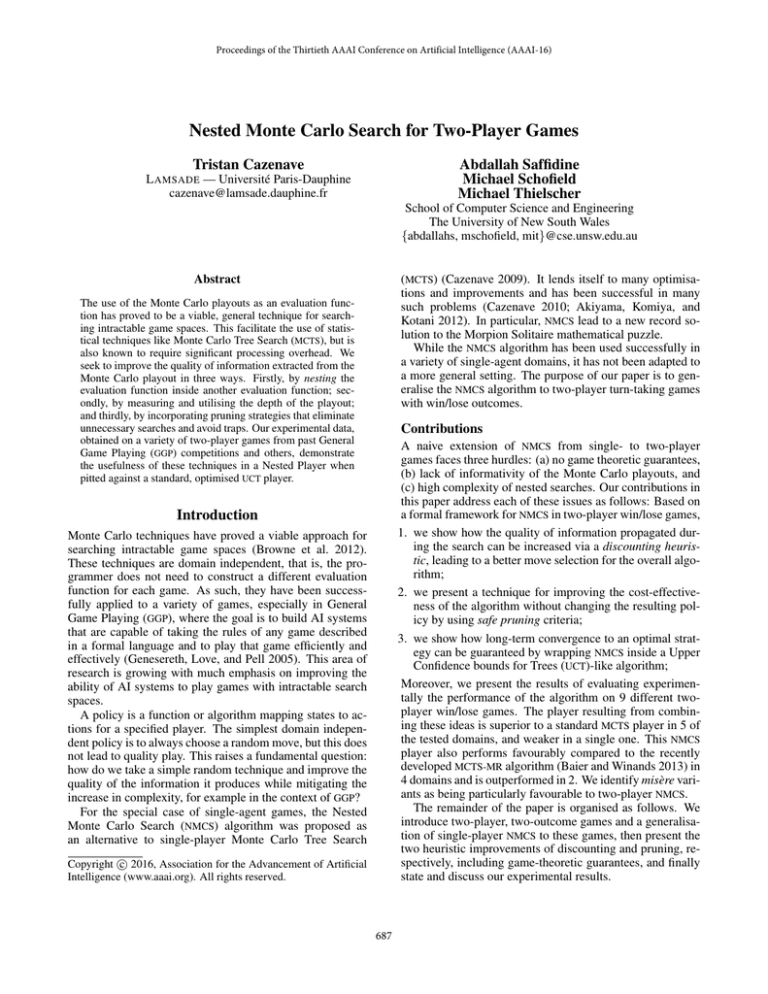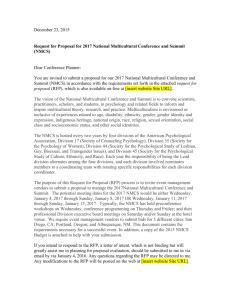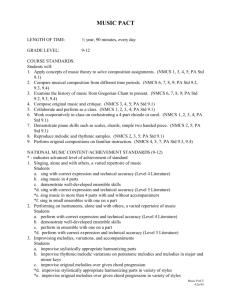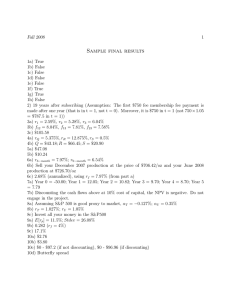
Proceedings of the Thirtieth AAAI Conference on Artificial Intelligence (AAAI-16)
Nested Monte Carlo Search for Two-Player Games
Tristan Cazenave
Abdallah Saffidine
Michael Schofield
Michael Thielscher
L AMSADE — Université Paris-Dauphine
cazenave@lamsade.dauphine.fr
School of Computer Science and Engineering
The University of New South Wales
{abdallahs, mschofield, mit}@cse.unsw.edu.au
(MCTS) (Cazenave 2009). It lends itself to many optimisations and improvements and has been successful in many
such problems (Cazenave 2010; Akiyama, Komiya, and
Kotani 2012). In particular, NMCS lead to a new record solution to the Morpion Solitaire mathematical puzzle.
While the NMCS algorithm has been used successfully in
a variety of single-agent domains, it has not been adapted to
a more general setting. The purpose of our paper is to generalise the NMCS algorithm to two-player turn-taking games
with win/lose outcomes.
Abstract
The use of the Monte Carlo playouts as an evaluation function has proved to be a viable, general technique for searching intractable game spaces. This facilitate the use of statistical techniques like Monte Carlo Tree Search (MCTS), but is
also known to require significant processing overhead. We
seek to improve the quality of information extracted from the
Monte Carlo playout in three ways. Firstly, by nesting the
evaluation function inside another evaluation function; secondly, by measuring and utilising the depth of the playout;
and thirdly, by incorporating pruning strategies that eliminate
unnecessary searches and avoid traps. Our experimental data,
obtained on a variety of two-player games from past General
Game Playing (GGP) competitions and others, demonstrate
the usefulness of these techniques in a Nested Player when
pitted against a standard, optimised UCT player.
Contributions
A naive extension of NMCS from single- to two-player
games faces three hurdles: (a) no game theoretic guarantees,
(b) lack of informativity of the Monte Carlo playouts, and
(c) high complexity of nested searches. Our contributions in
this paper address each of these issues as follows: Based on
a formal framework for NMCS in two-player win/lose games,
1. we show how the quality of information propagated during the search can be increased via a discounting heuristic, leading to a better move selection for the overall algorithm;
2. we present a technique for improving the cost-effectiveness of the algorithm without changing the resulting policy by using safe pruning criteria;
3. we show how long-term convergence to an optimal strategy can be guaranteed by wrapping NMCS inside a Upper
Confidence bounds for Trees (UCT)-like algorithm;
Moreover, we present the results of evaluating experimentally the performance of the algorithm on 9 different twoplayer win/lose games. The player resulting from combining these ideas is superior to a standard MCTS player in 5 of
the tested domains, and weaker in a single one. This NMCS
player also performs favourably compared to the recently
developed MCTS-MR algorithm (Baier and Winands 2013) in
4 domains and is outperformed in 2. We identify misère variants as being particularly favourable to two-player NMCS.
The remainder of the paper is organised as follows. We
introduce two-player, two-outcome games and a generalisation of single-player NMCS to these games, then present the
two heuristic improvements of discounting and pruning, respectively, including game-theoretic guarantees, and finally
state and discuss our experimental results.
Introduction
Monte Carlo techniques have proved a viable approach for
searching intractable game spaces (Browne et al. 2012).
These techniques are domain independent, that is, the programmer does not need to construct a different evaluation
function for each game. As such, they have been successfully applied to a variety of games, especially in General
Game Playing (GGP), where the goal is to build AI systems
that are capable of taking the rules of any game described
in a formal language and to play that game efficiently and
effectively (Genesereth, Love, and Pell 2005). This area of
research is growing with much emphasis on improving the
ability of AI systems to play games with intractable search
spaces.
A policy is a function or algorithm mapping states to actions for a specified player. The simplest domain independent policy is to always choose a random move, but this does
not lead to quality play. This raises a fundamental question:
how do we take a simple random technique and improve the
quality of the information it produces while mitigating the
increase in complexity, for example in the context of GGP?
For the special case of single-agent games, the Nested
Monte Carlo Search (NMCS) algorithm was proposed as
an alternative to single-player Monte Carlo Tree Search
c 2016, Association for the Advancement of Artificial
Copyright Intelligence (www.aaai.org). All rights reserved.
687
Nested Monte Carlo Search
It is easy to see that the computational cost of this algorithm grows exponentially with the nesting level. Two ideas
allow to improve the cost-effectiveness of two-player NMCS.
Using the playout depth for discounting increases the evaluation function quality without increasing cost; Safe search
pruning reduces the cost of the evaluation function without
reducing its quality.
We now describe two-player two-outcome games. These
games have two possible type of terminal states, labelled −1
and 1. The minimizing player is trying to reach a −1 state
while the maximizing player tries to end in a 1 terminal state.
Formally, a game is a tuple S, T, v, δ, τ where S is a set
of states in the game, T ⊆ S is the set of terminal states,
and D = S \ T is the set of decision states. v : T →
{−1, 1} is the payoff function on termination. δ : D →
2S is the successor function, i.e., δ(s) is the set of states
reachable from s in one step. τ : D → {min, max} is the
turn function, indicating which role choose the next action.
A move selection policy is a mapping from decision states
to distribution probabilities across states, π : D → φ(S).1
Policies can only select successor states, so for any state d ∈
D and any policy π, the support of π(d) is contained in δ(d).
The uniform policy returns any successor state with the same
probability.
A playout is a sequence of successive states ending in a
terminal state, i.e., for s0 s1 . . . st we have si+1 ∈ δ(si ) and
st ∈ T . Let π be a policy, the playout function of π, Pπ ,
maps input states to sequences of states drawn according to
π. That is, for any state s ∈ S, Pπ (s) = s0 . . . st where
s0 = s and si+1 ∼ π(si ). Note that we could also define
playout functions using a different policy for each role, but
it is not required for the rest of the paper. The Monte Carlo
playout is a playout function of the uniform policy.
A (stochastic) evaluation function is a mapping from
states to (distributions over) real values. Let Pπ be the playout function of some policy π. The evaluation function of
Pπ , written V (Pπ ), maps states to the payoff of the terminal
state reached with Pπ from these states. For example, for a
state s, if Pπ (s) returns s0 . . . st , then V (Pπ , s) would return v(st ). If π is a stochastic policy, then different playouts
can result from the same starting state, different rewards can
be obtained, and V (Pπ ) is thus stochastic as well.
Conversely, given an evaluation function f , it is possible
to build a corresponding policy Π(f ) by choosing the successor maximizing (resp. minimizing) the evaluation function on max (resp. min) decision states. This duality between policies and evaluation functions is the main intuition
behind the NMCS algorithm.
Heuristic Improvement I: Discounting
The naive porting of NMCS to two-outcome games described
in the previous section results in only two classes of moves
at each search nodes: moves that have lead to a won subplayout and moves that have lead to a lost sub-playout. One
of the main differences between two-outcome two-player
games and the single-agent domains in which NMCS is successful is that the latter offer a very wide range of possible
game outcomes. These different game outcomes help distinguish moves further.
The discounting heuristic turns a win/loss game into a
game with a wide range of outcomes by having the max
player preferring short wins to long wins, and long losses
to short losses. The intuition here is to win as quickly as
possible so as to minimize our opponent’s chance of finding
an escape, and to lose as slowly as possible so as to maximize our chance of finding an escape.
This idea can be implemented by replacing the V operator in the definition of NMC() by a discounting version VD .
The new VD operator is such that if Pπ (s) returns s0 . . . st ,
t)
VD (Pπ , s) would return v(s
t+1 . This way, the ordering between game outcomes corresponds exactly to the ordering
between the scores considered as real numbers. We call the
resulting playout function NMCD ().
While our application of discounting playouts to NMCS is
new, the idea has already appeared for MCTS in two flavours.
Just like us, Finnsson and Björnsson (2008) discount on
the length of the playout whereas Steinhauer (2010) discounts on how long ago a playout was performed. Nevertheless, Two important differences exist between Finnsson
and Björnsson (2008)’s approach and ours. First, theirs addresses scores ranging from 0 to 100 while ours use {−1, 1}.
As a result, long and short losses are not treated differently
in their work. Second, discounted rewards only affect the
selection in the NMCS part of our algorithm and full loss/win
results are propagated in the UCT tree.
Definition 1. For any nesting level n, NMC(n) is a playout function that maps states to playouts. We define it by
induction as follows: NMC(0) is the Monte Carlo playout
function, and NMC(n + 1) = PΠ(V (NMC(n))) .
Game-theoretic guarantees
For example, to obtain an NMC(2) playout from an input
state s, the algorithm first evaluates each of the |δ(s)| successor states by playing out a full game using an NMC(1) playout for each role. Each NMC(1) playout would use Monte
Carlo playouts for each move choice for the length of the
game. After the NMC(1) results have been gathered for the
successors of s, the algorithm chooses a successor state by
maximizing or minimizing over these results depending on
the turn player. This procedure is iterated until a terminal
state is reached by the main procedure.
1
A close examination of the tree of nodes reached during an
NMC (n) or NMC D (n) call shows that it contains small full
minimax trees of depth n rooted at each node of the returned
playout. In particular, a minimax search has been performed
in the first node of the playout and the following propositions
can be derived easily.
Proposition 1. If there is a forced win or loss in n moves
from a state s, the value V (NMC(n), s) returned by the NMCS
algorithm with nested level n is correct.
Proposition 2. If there is a forced win or loss in n+1 moves
from a state s, the move Π(VD (NMCD (n)), s) recommended
The notation φ(S) denotes the set of distributions over S.
688
a0
a1
a2
a3
a4
Current
state s0
8
7
6
5
4
3
2
1
Future
state s1
Playout
Payoff
values
(b) White’s winning move is
a5-a6. b6-a7 and b6-c7
initially seem good but are blunders.
Table 1: Effect of discounting on the distribution of nested
level 2 policies applied to Figure 1a, across 1000 games.
a0
a1
a2
a3
a4
Π(V (NMC(2)))
1
Frequency
Value
Frequency
{0}
{0, 1}
{0, 1}
{1}
{0, 1}
0
176
123
575
126
{0}
{0}
{0, 14 }
{ 12 }
{0, 14 }
0
0
0
1000
0
1
Cut on Win
(b)
-1
1
1
Prune on Depth
(c)
ing NMCS to two-player games also gives pruning opportunities that were absent in the single-player case.
Π(VD (NMCD (2)))
Value
-1
Figure 2: Effect of the pruning strategies on an NMCS run.
We assume a max root state and a left-to-right evaluation
order. (a) In the standard case, the second and the fourth
successor states are equally preferred. With discounting, the
fourth successor state is the most-preferred one. (b) This
fourth state may fail to be selected when Cut on Win is enabled. (c) With Pruning on Depth and discounting, however,
this fourth state would be found and preferred too.
Figure 1: Partially played games of TicTacToe and Breakthrough with a single winning move for the turn player.
Move
-1
-1
(a)
a b c d
(a) The X player is to
play. Any move except a3
leads to a draw with perfect play.
1
-1
Cut on Win The first pruning strategy, Cut on Win (COW),
hangs on two features of two-player win/loss games. First,
we know the precise value of the best outcome of the game.
Second, these values are reached regularly in playouts.
The COW strategy consists of evaluating the moves randomly and selecting the first move that returns the maximum value from its evaluation. This can be achieved
through replacing Π by a pruning version ΠCOW . Specifically, ΠCOW (f, s) would call f on one successor state of s
at a time, until one with a positive value is found in case
τ (s) = max, or with a negative value in case τ (s) = min,
and then discard all the remaining successors.
by the NMCS algorithm with nested level n and discounting
is optimal.
Proposition 1 holds whether discounting is used or not but
Proposition 2 does not hold in general for NMCS without discounting. Figure 1a provides a counter-example. Player X
has a theoretical win in 3 in this Tictactoe position and a3 is
the only correct move. Table 1 summarizes the data obtained
from calling Π(V (NMC(2))) and Π(VD (NMCD (2))) a 1000
times on this position. Value indicates the set of encountered
values across all the calls, and Frequency indicates how often the corresponding move has been selected by the policy.
Without discounting, moves a1 , a2 , and a4 are selected
occasionally in a tie break because they sometimes lead to
a won playout. With discounting, however, the shorter (and
guaranteed) win of a3 is always preferred to those occuring
after a2 and a4 . Note also that when discounting is used,
the embedded NMCD (2) selecting moves for the O player is
forcing a draw after move a1 .
Proposition 3. Assume that whenever a state is evaluated
using a nested playout, successor states are presented in a
random order. Then NMC(n) with COW generates the same
playout distribution as NMC(n) with no pruning.
Proposition 3 relies on no discounting being used. In general, NMCD (n) with COW is not guaranteed to have the same
distribution as NMCD (n), as illustrated in Figure 2(a)–(b).
Heuristic Improvement II: Pruning
Pruning on Depth The second pruning strategy, Prune on
Depth (POD), takes into account the richer outcome structure
offered by the discounting heuristic. In POD, the search does
not return at the first occurrence of a win, but whenever a
playout is bound to be longer than an already explored won
sibling. Put simply, in max (resp. min) states we prune states
deeper than the shallowest win (resp. loss), as depicted in
Figure 2(c). A safety result similar to that of COW can be
derived.
From the classical alpha-beta search (Knuth and Moore
1975) to the more recent Score-Bounded MCTS adaptation (Cazenave and Saffidine 2010), two-player games usually lend themselves quite well to pruning strategies. Adapt-
Proposition 4. Assume that whenever a state is evaluated
using a nested playout, move choices are randomly presented in the same order. Then NMCD (n) with no pruning
returns the same move as NMCD (n) with POD.
689
Table 2: Performance of NMC(3) and NMCD (3) starting
from Figure 1b, averaged over 900 runs; showing how discounting and pruning affect the number of states visited and
the correct move frequency.
Discounting
Pruning
States Visited(k)
Freq(%)
No
No
No
No
None
COW(≤ 1)
COW(≤ 2)
COW(≤ 3)
4, 459 ± 27
1, 084 ± 8
214 ± 2
25 ± 1
11.9 ± 2.2
12.3 ± 2.6
10.9 ± 2.0
9.8 ± 2.0
Yes
Yes
Yes
Yes
POD(≤ 1)
POD(≤ 2)
POD(≤ 3)
None
2, 775 ± 26
1, 924 ± 20
1, 463 ± 16
627 ± 19
64.1 ± 3.4
64.7 ± 3.5
58.6 ± 3.5
62.4 ± 3.3
Black must respond with b8-a7, otherwise White has a
certain win. Our experiments indicate that an NMC(2) player
selects b8-a7 15% of the time, whether COW is enabled or
not, whereas an NMCD (2) player selects this move 100% of
the time, whether POD is enabled or not.
Algorithm
As a summary, Algorithm 1 provides pseudo-code for our
generalisation of the NMCS algorithm to two-player games.
Lines 10, 5, and 13 respectively allow to enable the cut on
win, pruning on depth, and discounting heuristics.
Algorithm 1: Two-player two-outcome NMCS.
nested(nesting n, state s, depth d, bound λ)
2
while s ∈
/ T do
3
s∗ ← rand(δ(s))
1
∗
4
if τ (s) = max then l∗ ← −1
d else l ← d
∗
if d-pruning and τ (s){−l , λ} = λ then return λ
5
6
if n > 0 then
7
foreach s in δ(s) do
8
l ← nested(n − 1, s , d + 1, l∗ )
9
if τ (s){l, l∗ } = l∗ then s∗ ← s ; l∗ ← l
10
if cut on win and τ (s){l, 0} = 0 then break
11
s ← s∗
d←d+1
12
13
if discounting then return v(s)
d
else return v(s)
14
1
The Trade-off of Unsafe Pruning
Unlike the classical alpha-beta algorithm, the COW technique described previously is unsafe when using discounting: it may lead to a better move being overlooked. Unsafe
pruning methods are common in the game search community, for instance null move and forward pruning (Smith and
Nau 1994), and the attractiveness of a new method depends
on the speed versus accuracy trade-off.
As an illustrative example, we look at the game of Breakthrough being played in Figure 1b.2 This position was used
as a test case exhibiting a trap that is difficult to avoid for
a plain UCT player (Gudmundsson and Björnsson 2013).
The correct move for White is a5-a6, however b6-a7 and
b6-c7 initially look strong.
We generate multiple NMC(3) and NMCD (3) playouts
with different parameter settings, starting from this position. For each parameter setting, we record the number of
states visited and the likelihood of selecting the correct initial move and present the results in Table 2. A setting of the
type COW(≤ i) is to be understood as Cut on Win pruning
heuristic was activated at nesting levels i and below but not
at any higher level. Each entry in the table is an average of
900 runs, and the 95% confidence interval on standard error
of the mean is reported for each entry.
Observe from Table 2 that (a) Discounting improves the
likelihood of finding the best move from 0.11 to 0.63; (b) all
pruning strategies significantly reduce the search effort;
(c) the performance of a non-discounted (resp. discounted)
search is not significantly affected by COW (resp. POD), as
predicted by Proposition 3 (resp. 4); and (d) POD(≤ 3) is 25
times as expensive as COW(≤ 3), but much more accurate.
The quality of the choices being made by the level 3 policy is built on the quality of the choices being made by the
embedded level 2 player for both Black and White roles.
Remember that the move b6-a7 is a trap for White as it
eventually fails, but the Black level 2 player must spring the
trap for the White level 3 playout to “get it right”.
Experimental Results
Domains
We use 9 two-player games drawn from games commonly
played in GGP competitions, each played on a 5 × 5 board.
Breakthrough and Knightthrough are racing games where
each player is trying to get one their piece across the board,
these two games are popular as benchmarks in the GGP community.
Domineering and NoGo are mathematical games in which
players gradually fill a board until one of them has no legal
moves remaining and is declared loser, these two games are
popular in the Combinatorial Game Theory community.
For each of these domain, we construct a misère version,
which has exactly the same rules but with reverse winning
condition. For instance, a player wins misère Breakthrough
if they force their opponent to cross the board.
To this list, we add AtariGo, a capturing game in which
each player tries to surround the opponent’s pieces. AtariGo
is a popular pedagogical tool when teaching the game of Go.
Performance of the playout engine
It is well known in the games community that increasing the strength of a playout policy may not always result in a strength increase for the wrapping search (Silver
and Tesauro 2009). Still, it often is the case in practice,
and determining whether our discounting heuristic improves
2
Knowing the rules of Breakthrough is not essential to follow
our analysis. However, the reader can find a description of the
rules in related work (Saffidine, Jouandeau, and Cazenave 2011;
Gudmundsson and Björnsson 2013).
690
per second (k)
79.6
42.4
78.6
46.0
71.2
43.4
62.8
53.2
69.6
99.6
80.8
100.0
83.2
77.0
63.2
76.4
65.6
97.2
99.4
90.0
100.0
85.8
83.8
68.4
83.4
67.2
100.0
411
409
264
328
550
592
357
648
280
Game
misère
NoGo
Domineering
the strength of nested playout policies may prove informative. For each of the nine domains of interest, and for
each level of nesting n from 0 to 2, we run a match between Π(VD (NMCD (n))) and Π(V (NMC(n))). 500 games
are played per match, 250 with each color, and we provide
the winrates of the discounting nested player in Table 3.
The performance of the wrapping search may also be affected by using a slower playout policy. Fortunately, discounting does not slow NMCS down in terms of states visited per second, and preliminary experiments revealed that
discounting even decreases the typical length of playouts,
thereby increasing the number of playouts performed per
second. As a reference for subsequent fixed-time experiments, we display the game engine speed in thousands of
visited states per second in the last column of Table 3. The
experiments are run on a 3.0 GHz PC under Linux.
misère
2
misère
1
misère
0
Parameters and Performance against UCT
AtariGo
We want to determine whether using nested rather than plain
Monte Carlo playouts could improve the performance of a
UCT player in two-player games in a more systematic way.
We also want to measure the effect of the heuristics proposed
in the previous section.
We therefore played two versions of MCTS against each
other in a variety of domains. One runs the UCT algorithm
using nested playouts (labelled NMCS) and the other is a
standard MCTS, i.e., an optimised UCT with random playouts.
Both players are allocated the same thinking time, ranging
from 10ms per move to 320ms per move. We try several parameterisation of NMCS: nesting depth 1 or 2, COW, and the
combination of discounting and POD. For each game, each
parameter setting, and each time constraint, we run a 500
games match where NMCS plays as first player 250 times
and we record how frequently NMCS wins in Table 4.
The first element that we can notice in Table 4 is that both
discounting and COW improve significantly the performance
of NMCS over using level 1 playouts with no heuristics. We
can also observe that for this range of computational resources, using a level 2 nested search for the MCTS playouts
does not seem as effective as using a level 1 nested search.
In two domains, Knightthrough and Domineering, the
winrate converges to 50% as the time budget increases.
n
States visited
Breakthrough
Breakthrough
misère
Knightthrough
misère
Domineering
misère
NoGo
misère
AtariGo
Nesting Level
Knightthrough
Game
COW
POD
Table 4: Win percentages of NMCS against a standard MCTS
player for various settings and thinking times.
Table 3: Winrates (%) of NMCS with discounting vs. NMCS
without it for nesting levels 0 to 2 and game engine speed.
10ms
20ms
40ms
80ms 160ms 320ms
1
1 1
2
3.2
27.6
22.6
4.6
6.0
22.6
25.2
2.0
12.0
16.8
30.4
2.4
11.6
21.6
34.6
1.4
7.8
15.4
35.2
2.4
6.4
20.4
39.6
3.8
1
1 1
2
85.4
91.4
95.2
1.0
83.4
95.6
95.2
27.6
70.2
97.0
98.0
43.6
60.8
97.8
99.0
87.0
57.0
98.8
99.8
93.2
56.4
98.8
99.8
95.6
1
1 1
2
42.2
68.6
27.2
20.0
57.2
50.2
25.4
16.4
9.8
42.4
28.0
5.8
49.4
42.4
43.4
1.8
50.2
46.4
49.2
29.2
50.0
44.6
49.6
38.2
1
1 1
2
43.0
54.6
77.8
20.8
31.6
72.2
82.2
18.6
20.0
80.6
88.8
32.2
15.4
88.4
94.4
42.2
11.2
94.2
98.2
54.0
12.6
98.4
98.6
67.0
1
1 1
2
13.4
40.8
44.4
11.2
8.6
34.4
38.6
14.4
8.6
37.4
40.6
20.2
6.0
48.4
49.4
25.2
14.2
50.0
50.0
32.2
28.0
50.0
50.0
45.4
1
1 1
2
33.4
45.4
69.4
37.0
25.2
47.2
66.6
45.2
20.0
56.8
71.6
45.6
18.8
60.2
70.4
51.0
13.2
62.8
68.4
57.8
12.2
54.2
58.6
53.6
1
1 1
2
5.8
7.2
37.6
0.4
3.0
16.0
39.2
2.8
2.6
31.8
38.4
5.4
3.0
35.2
40.8
15.0
0.6
35.4
47.8
20.6
0.8
40.6
48.0
17.0
1
1 1
2
14.6
17.2
55.4
5.2
6.6
25.0
56.6
10.6
5.2
38.8
57.0
19.4
3.0
51.2
57.6
35.6
2.4
48.2
54.6
37.2
1.8
48.8
60.8
47.8
1
1 1
2
0.6
0.2
42.0
0.2
2.2
19.2
59.0
0.0
4.6
42.0
60.2
0.6
5.4
42.0
71.0
7.4
6.8
55.4
71.2
8.6
7.6
67.2
77.2
4.8
Manual examination indicates that the same side wins almost every game, no matter which algorithm plays White.
We interpret this to mean that Domineering and Knightthrough appear to be an easy task for the algorithms at hand.
On the other hand, the large proportion of games lost by
the reference MCTS player independent of the side played
demonstrate that some games are far from being solved by
this algorithm, for instance misère Breakthrough, misère
Knightthrough, or AtariGo are dominated by NMCS. This
shows that although all 9 games were played on boards of
the same 5 × 5 size, the underlying decision problems were
of varying difficulty.
The performance improvement on the misère version of
the games seems to be much larger than on the original versions. A tentative explanation for this phenomenon which
would be consistent with a similar intuition in single-agent
691
Table 5: Win percentages of NMCS and MCTS-MR against
standard MCTS with 320ms per move. NMCS uses COW and
depth 1 while MCTS-MR uses depth 1 and 2.
Game
NMCS
MR 2
39.6
99.8
47.4
49.4
50.2
48.6
Knightthrough
misère
49.6
98.6
50.0
49.8
50.0
45.0
Domineering
misère
50.0
58.6
50.0
46.0
49.8
44.2
NoGo
48.0
60.8
59.4
54.2
50.2
67.4
77.2
44.0
47.0
AtariGo
The NMCS algorithm was proposed as an alternative to
single-player MCTS for single-agent domains (Cazenave
2009). It lends itself to many optimisations and improvements and has been successful in many such problems (Cazenave 2010; Akiyama, Komiya, and Kotani 2012).
In particular, NMCS lead to a new record solution to the Morpion Solitaire mathematical puzzle.
In this paper, we have examined the adaptation of
the NMCS algorithm from single-agent problems to twooutcome two-player games. We have proposed two types
of heuristic improvements to the algorithm and have shown
that these suggestions indeed lead to better performance than
that of the naive adaptation. In particular, discounting the reward based on the playout length increases the accuracy of
the nested searches, and the various pruning strategies allow
the discarding of very large parts of the search trees.
Together these ideas contribute to creating a new type
of domain agnostic search-based artificial player which appears to be much better than a classic UCT player on some
games. In particular, in the games misère Breakthrough and
misère Knightthrough the new approach wins close to 99%
of the games against the best known domain independent
algorithm for these games.
In terms of related work, the intuition behind NMCS
inspired the Nested Rollout Policy Adaptation algorithm
which enabled further record establishing performances in
similar domains (Rosin 2011). The idea of nesting searches
of a certain type has also been used with MCTS to build
opening books (Chaslot et al. 2009), with Proof Number
Search to distribute it over a cluster (Saffidine, Jouandeau,
and Cazenave 2011), and with Perfect Information Monte
Carlo (PIMC) search as a way to alleviate the strategy fusion
and non-local dependencies problems exhibited by PIMC in
imperfect information games (Furtak and Buro 2013).
Méhat and Cazenave (2010) compare NMCS and the UCT
algorithm for single player games with mixed results. They
explore variants of UCT and NMCS and conclude that neither one is a clear winner. Pepels et al. (2014) have shown
in the context of MCTS that more information than a binary
outcome could be extracted from a random playout, even
when very little domain knowledge is available. In particular, the outcome of a short playout might be more informative than that of a longer one because fewer random actions
have taken place.
Some important improvements to the original singleplayer NMCS algorithm such as memorization of the best
sequence (Cazenave 2009) cannot be adapted to the twoplayer setting because of the alternation between maximizing and minimizing steps. Still, nothing prevents attempting
to generalize some of the other heuristics such as the AllMoves-As-First idea (Akiyama, Komiya, and Kotani 2012)
and the Nested Rollout Policy Adaptation (Rosin 2011) in
future work. Future work could also examine how to further
generalize NMCS to multi-outcome games.
While we built our Nested Player around a purely random
policy as is most common in the GGP community (Björnsson
and Finnsson 2009; Méhat and Cazenave 2010; Genesereth
and Thielscher 2014), our technique could also build on the
MCTS-MR
MR 1
Breakthrough
misère
misère
Discussion
domains is that NMCS is particularly good at games where
the very last moves are crucial to the final score. Since the
last moves made in a level n playout are based on a search
of an important fraction of the subtree, comparatively fewer
mistakes are made at this stage of the game than a plain
Monte Carlo playout. Therefore, the estimates of a position’s value are particularly more accurate for the nested
playouts than for Monte Carlo playouts. This is consistent
with the fact that NMCS is performing a depth-limited Minimax search at the terminus of the playout.
Comparison to MCTS-MR
The idea of performing small minimax searches in the
playout phase of MCTS has been formally studied recently
with the development of the MCTS with Minimax Rollouts
(MCTS-MR) algorithm (Baier and Winands 2013). Previous work has shown that searches of depth 1 improve the
performance of MCTS engines in Havannah (Lorentz 2010;
Ewalds 2012), and searches of depth 2 improve the performance in Connect 4 (Baier and Winands 2013) and Lines of
Action (Winands and Björnsson 2011).
NMCS explores small minimax trees at every node of
a playout, but also creates sub-playouts. To determine
whether the performance gains observed in Table 4 are entirely due to this minimax aspect, we compare the performance of NMCS with that of MCTS-MR. According to Table 4, the best parameter setting for NMCS is a nesting
depth of n = 1 with COW pruning but no discounting. For
MCTS-MR, we use searches of depth 1 and 2. In Table 5, the
numbers represent the winrate percentage againt a standard
MCTS opponent over 500 games.
Except in NoGo and misère NoGo, the MCTS-MR algorithm does not improve performance over standard MCTS.
Therefore, our tentative explanation that the NMCS performance boost could be attributed to its avoiding late-game
blunders via Minimax is only supported in misère NoGo.
For the other misère games, it appears that improving the
simulation quality at every step of the playouts is responsible for the particularly good performance of NMCS.
692
alternative domain-specific pseudo-random policies developed in the Computer Go community (Silver and Tesauro
2009; Browne et al. 2012). The interplay between such
smart elementary playouts and our nesting construction and
heuristics could provide a fruitful avenue for an experimentally oriented study.
Furtak, T., and Buro, M. 2013. Recursive Monte Carlo search
for imperfect information games. In IEEE Conference on
Computational Intelligence and Games (CIG) (2013), 225–
232.
Genesereth, M., and Thielscher, M. 2014. General Game
Playing. Synthesis Lectures on Artificial Intelligence and
Machine Learning. Morgan & Claypool.
Genesereth, M.; Love, N.; and Pell, B. 2005. General game
playing: Overview of the AAAI competition. AI Magazine
26(2):62–72.
Gudmundsson, S. F., and Björnsson, Y. 2013. Sufficiencybased selection strategy for MCTS. In 23rd International
Joint Conference on Artificial Intelligence (IJCAI), 559–565.
Beijing, China: AAAI Press.
Knuth, D. E., and Moore, R. W. 1975. An analysis of alphabeta pruning. Artificial Intelligence 6(4):293–326.
Lorentz, R. J. 2010. Improving Monte–Carlo tree search
in havannah. In 7th International Conference on Computers
and Games (CG) (2010). 105–115.
Méhat, J., and Cazenave, T. 2010. Combining UCT and
nested Monte-Carlo search for single-player general game
playing. IEEE Transactions on Computational Intelligence
and AI in Games 2(4):271–277.
Pepels, T.; Tak, M. J.; Lanctot, M.; and Winands, M. H.
2014. Quality-based rewards for Monte-Carlo Tree Search
simulations. In 21st European Conference on Artificial Intelligence (ECAI), volume 263 of Frontiers in Artificial Intelligence and Applications, 705–710. Prague, Czech Republic:
IOS Press.
Rosin, C. D. 2011. Nested rollout policy adaptation for
Monte Carlo tree search. In 22nd International Joint Conference on Artificial Intelligence (IJCAI), 649–654. Barcelona,
Catalonia, Spain: AAAI Press.
Saffidine, A.; Jouandeau, N.; and Cazenave, T. 2011. Solving
Breakthough with race patterns and Job-Level Proof Number Search. In 13th International Conference on Advances
in Computer Games (ACG), volume 7168 of Lecture Notes
in Computer Science, 196–207. Tilburg, The Netherlands:
Springer.
Silver, D., and Tesauro, G. 2009. Monte-Carlo simulation
balancing. In 26th International Conference on Machine
Learning (ICML), 945–952. Montreal, Quebec, Canada:
ACM.
Smith, S. J., and Nau, D. S. 1994. An analysis of forward
pruning. In 12th National Conference on Artificial Intelligence (AAAI), 1386–1391. Seattle, WA, USA: AAAI Press.
Steinhauer, J. 2010. Monte-Carlo twixt. Master’s thesis,
Maastricht University, Maastricht, The Netherlands.
Winands, M. H., and Björnsson, Y. 2011. αβ -based playouts in Monte-Carlo Tree Search. In IEEE Conference
on Computational Intelligence and Games (CIG), 110–117.
Seoul, South Korea: IEEE Press.
Acknowledgments
This research was supported by the Australian Research
Council under grant no. DP120102023 and DE150101351.
The last author is also affiliated with the University of Western Sydney.
This work was granted access to the HPC resources of
MesoPSL financed by the Region Ile de France and the
project Equip@Meso (reference ANR-10-EQPX-29-01) of
the programme Investissements d’Avenir supervised by the
Agence Nationale pour la Recherche.
References
Akiyama, H.; Komiya, K.; and Kotani, Y. 2012. Nested
Monte-Carlo search with simulation reduction. KnowledgeBased Systems 34:12–20.
Baier, H., and Winands, M. H. 2013. Monte-Carlo tree
search and minimax hybrids. In IEEE Conference on Computational Intelligence and Games (CIG) (2013), 1–8.
Björnsson, Y., and Finnsson, H. 2009. CADIAPLAYER:
A simulation-based general game player. IEEE Transactions
on Computational Intelligence and AI in Games 1(1):4–15.
Browne, C.; Powley, E.; Whitehouse, D.; Lucas, S.; Cowling, P.; Rohlfshagen, P.; Tavener, S.; Perez, D.; Samothrakis,
S.; and Colton, S. 2012. A survey of Monte Carlo tree search
methods. IEEE Transactions on Computational Intelligence
and AI in Games 4(1):1–43.
Cazenave, T., and Saffidine, A. 2010. Score bounded MonteCarlo tree search. In 7th International Conference on Computers and Games (CG) (2010), 93–104.
Cazenave, T. 2009. Nested Monte-Carlo search. In 21st
International Joint Conference on Artificial Intelligence (IJCAI), 456–461. Pasadena, California, USA: AAAI Press.
Cazenave, T. 2010. Nested Monte-Carlo expression discovery. In 19th European Conference on Artificial Intelligence
(ECAI), 1057–1058. Lisbon, Portugal: IOS Press.
2010. 7th International Conference on Computers and
Games (CG), volume 6515 of Lecture Notes in Computer
Science, Kanazawa, Japan: Springer.
Chaslot, G. M.-B.; Hoock, J.-B.; Perez, J.; Rimmel, A.; Teytaud, O.; and Winands, M. H. 2009. Meta Monte-Carlo Tree
Search for automatic opening book generation. In 1st International General Game Playing Workshop (GIGA), 7–12.
2013. IEEE Conference on Computational Intelligence and
Games (CIG), Niagara Falls, Canada: IEEE Press.
Ewalds, T. 2012. Playing and solving Havannah. Master’s
thesis, University of Alberta.
Finnsson, H., and Björnsson, Y. 2008. Simulation-based
approach to general game playing. In AAAI, volume 8, 259–
264.
693







